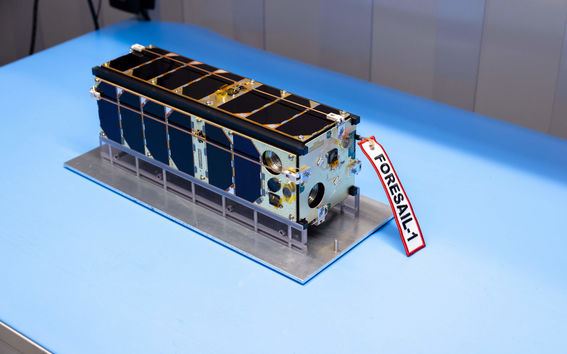The science satellite Foresail-1 was successfully launched into space 25 May

Updated 30th May 2022
The science satellite Foresail-1 was successfully launched into space late in the evening Finnish time on May 25th, at SpaceX's Falcon 9 rocket from Cape Canaveral, Florida. A total of 59 nanosatellites were involved in the rocket mission called Transporter 5, and five nanosatellites from the Finnish space company ICEYE also travelled into space. The first signal from the Foresail-1 satellite was picked up by the international SatNOGS network soon after the launch, and later also by the Otaniemi ground station in Espoo.
"The satellite is successfully in orbit and regularly sends information about its condition - the batteries are recharging, and the solar panels are working. Minor repairs related to the satellite control are currently being made, but everything seems to be in order on the satellite itself says mission leader and Aalto University Assistant Professor Jaan Praks.
*************
It is time for Foresail-1, the first satellite from the Finnish Centre of Excellence in Research of Sustainable Space, to shine. Foresail-1 has been loaded into the SpaceX company’s Falcon 9 rocket, which is scheduled to launch from Cape Canaveral Space Centre in Florida, on Wednesday, 25 May.
“The launch has been scheduled for 21:25 Finland time. According to local weather forecasts, the launch should take place on schedule,” says mission leader and Aalto University Assistant Professor Jaan Praks.
SpaceX’s rocket mission, Transporter 5, will carry dozens of small satellites to an orbit at 550 kilometres. Foresail-1 will make one rotation around the Earth in roughly an hour and a half, and will pass over Finland every day at roughly the same time.
“If everything goes well and the satellite activates as planned, we're expecting the first signal at the ground station in Otaniemi in a few hours after launch.”
More sustainable space research
All the satellite systems and scientific instruments of Foresail-1 have been developed and built in Finland.
The satellite will carry two unique scientific instruments – the PATE particle telescope, which will study the near-Earth radiation environment, and a plasma brake, which will bring the satellite out of orbit.
The plasma brake aims to significantly reduce the amount of space debris in the orbits by accelerating the process to bring the decommissioned satellite back into the atmosphere, where it goes up in smoke. Normally it takes years for satellites to sink into the atmosphere, but thanks to the plasma brake, it could take only as little as a few months.
The goal of the PATE particle telescope, developed at the University of Turku, is to help researchers to better understand the radiation environment of space and thus extend the life of satellites in space.
“With long-term funding from the Academy of Finland, we have created Finland’s first scientific space programme, which aims to develop more sustainable space research. Our first space-bound satellite is an important part of our research work, and hopefully we will get to test some theories in practice,” says University of Helsinki professor Minna Palmroth, director of the Centre of Excellence.
You can follow the launch here.
Image and video material of the Foresail-1 satellite is available for download here.
Press release, 12 April 2022: Foresail-1 is ready for space
Further information:
Jaan Praks (further information related to the operation and launch of the Foresail-1 satellite)
Assistant Professor, Aalto University
tel. + 358 50 420 5847
[email protected]
Minna Palmroth
Professor and Director of the Centre of Excellence, University of Helsinki
tel. + 358 40 531 1745
[email protected]
The Finnish Centre of Excellence in Research of Sustainable Space brings together Finland's leading experts in space science and technology and intends to revolutionise experimental space physics with the help of nanosatellites. At the same time, it wants to protect Earth’s orbits from the space debris that threatens them. The Centre of Excellence is headed by Professor Minna Palmroth from the University of Helsinki and consists of research groups from the University of Helsinki, Aalto University, the University of Turku, and the Finnish Meteorological Institute.
- Published:
- Updated:
Read more news

DeployAI Partners Gather for Heart Beat Meeting in Helsinki
The European DeployAI project's partners gathered for the Heart Beat meeting hosted by Aalto University Executive Education in Helsinki.
Get to know us: Associate Professor Maria Sammalkorpi
Sammalkorpi received her doctorate from Helsinki University of Technology 2004. After her defence, she has worked as a researcher at the Universities of Princeton, Yale and Aalto.
Aalto computer scientists in ICML 2024
Computer scientists in ICML 2024